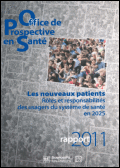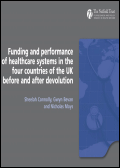LU POUR VOUS DE MARS 2012 :
 livres du mois
livres du mois
 sites du mois
sites du mois
 working papers
working papers
Tous les lu pour vous
LES LIVRES DU MOIS
Les soins de santé primaires : critiques d'une orthodoxie.
Edouard R., Clément M.
Québec : Presses de l'Université du Québec : 2010 : 164 p.
Depuis la Conférence d'Alma Ata, en 1978, les soins de santé primaires (SSP) ont changé de nature. On en a fait la pierre angulaire de toute réforme des systèmes de santé. Aussi est-ce quasiment un problème moral aujourd'hui d'en questionner l'omniprésence. Comment en sommes-nous arrivés là ? Qu'est-ce qui fait que les SSP ont pu nous apparaître si nécessaires qu'on en ait fait une orthodoxie ? Mais, en fait, de quoi s'agit-il ? Qui sont les acteurs de cette transformation de vocation ? Au nom de quelles promesses ? Pour quels résultats ? Cet ouvrage questionne les aboutissements, la pertinence et les finalités latentes de l'orthodoxie des SSP, c'est-à-dire leur généralisation. Les auteurs mettent en évidence certains risques de dérive inhérents à la promesse de santé pour tous ainsi que la propension, paradoxale, que le principe d'équité promu par cette orthodoxie (re)produise les inégalités qu'elle prétend pourtant combattre. Les auteurs dévoilent ici, outre ses mécanismes de fonctionnement, certaines des limites jusque-là insurmontables de l'orthodoxie des SSP. Ils expliquent du même coup pourquoi elle est bien plus efficace en termes de production idéologique qu'en termes de résultats probants (4e de couverture).
Les nouveaux patients. Rôles et responsabilités des usagers du système de santé en 2025. Rapport 2011.
Degos L., Evin C., De Jouvenel H., Saout C. et al., Tabuteau D. /dir
Paris : Editions de santé ; Paris : Les Presses de Sciences Po : 2011 : 128 p.
Cet ouvrage se penche sur la place, le rôle et les responsabilités des patients dans les évolutions du secteur de la santé. Quatre tendances lourdes structurent l'avenir dans le champ de la santé : le progrès technique, les évolutions démographiques et épidémiologiques, les transformations sociales et les enjeux du financement. Le patient, usager du système de santé, consommateur de soins, cotisant, est, sous ses diverses figures, au coeur des évolutions. Cet ouvrage livre une analyse prospective qui a pour objet d'identifier quelques tendances susceptibles d'éclairer ce que seront les patients en 2025 et d'analyser les enjeux des changements en perspective (d'après l'intro).
La vie professionnelle : âge, expérience et santé à l'épreuve des conditions de travail.
Molinie A.F., Gaudart C., Pueyo V., Lacomblez M., Leymarie C.
Toulouse : Octarès Editions : 2012 : 395 p.
Le thème de cet ouvrage est au cœur de l'actualité, compte tenu des changements démographiques et des transformations rapides dans le monde du travail. Les « seniors » sont de plus en plus nombreux dans les entreprises et les administrations, mais aussi de plus en plus nombreux à quitter la vie active. C'est une tendance marquée, durable, quelles que soient les hypothèses d'âge de départ. L'arrivée de « nouveaux » est elle aussi de plus en plus fréquente, pour remplacer des départs en retraite ou du fait d'une accélération des mobilités. Or, dans le même temps, le monde du travail se transforme, privilégiant à la fois la rationalisation et la réactivité. Les espaces de liberté, les possibilités d'anticiper, de s'organiser individuellement et collectivement, diminuent. Les temps non immédiatement productifs sont réduits, tels ceux consacrés à la formation et aux apprentissages, à l'accueil des nouveaux, aux échanges entre collègues. Ce livre invite à saisir le « fil de l'âge » pour proposer des repères, théoriques et pratiques, afin de comprendre ces transformations dans le travail et les parcours professionnels, et leurs enjeux, souvent préoccupants, en termes de santé au travail et d'expérience. Sur l'apprentissage, le développement des compétences, les ressources que peut - ou non - constituer le collectif, la santé au travail en fin de vie active, il existe des connaissances, des expériences, des pistes d'action, pour prendre en compte la diversité de la population et porter attention aux différents temps de la vie professionnelle. Les réflexions et les expériences que présente ce livre collectif sont étroitement liées aux problématiques et recherches développées depuis une vingtaine d'années au sein du Centre de recherches et d'études sur l'âge et les populations au travail (Créapt) (4e de couverture).
Médecins du travail / médecins généralistes : regards croisés.
Menard C., Demortiere G., Durand E. et al.
Saint-Denis : INPES : 2012 : 189 p.
Les facteurs de risques professionnels et la qualité de vie au travail deviennent des enjeux de plus en plus importants pour la santé des populations. Les professionnels de santé — médecins du travail et médecins généralistes — sont de plus en plus confrontés à l'impact de ces facteurs sur la santé de leurs patients : déclarations de maladies professionnelles, expression de souffrances psychiques, maladies aiguës ou chroniques, pratiques addictives, arrêts de travail prolongés ou récurrents. Dans ce contexte, les coopérations entre médecins du travail, médecins généralistes et, plus largement, réseaux de santé doivent se renforcer. Les médecins sont-ils préparés à élargir ainsi leurs champs d'action et de coopération ? La place du médecin du travail dans la prévention et la réduction des risques liés aux consommations de substances psychoactives en milieu professionnel est désormais définie dans le texte de loi relatif à l'organisation de la médecine du travail du 20 juillet 2011. Les recommandations du Haut Comité de la santé publique, le Plan Santé au travail (PST 2), le Plan national santé environnement (PNSE 2) ont pointé la nécessité de recommandations de bonnes pratiques dans ce domaine. Engagés aux côtés des pouvoirs publics dans des actions d'information, de formation et d'assistance aux professionnels de santé, l'Inpes, l'Institut national de recherche et de sécurité (INRS) et la Société de médecine du travail de l'Ouest de l'Île-de-France (SMTOIF) partagent dans cet ouvrage leurs champs d'études et de réflexion. Son objectif est de rendre compte de l'activité des professionnels de santé dans le champ de la santé au travail au travers de deux études distinctes mais complémentaires. La première, réalisée et financée par l'Inpes, l'INRS et la SMTOIF, porte sur l'implication des médecins du travail dans le champ de la santé publique, et plus particulièrement des pratiques addictives : quel(s) rôle(s) pour les médecins du travail dans la prévention de ces pratiques en milieu professionnel ? Comment sont-ils sollicités pour mettre en œuvre des actions collectives de prévention ? Quelles sont leurs opinions sur les tests de dépistage ? La seconde, réalisée et financée par l'Inpes, analyse les opinions et pratiques des médecins généralistes en santé au travail : comment conçoivent-ils leur rôle ? Quelles pathologies liées au travail rencontrent-ils ? Quelles occasions ont-ils de solliciter les médecins du travail ? Un volet commun aux deux enquêtes interroge les perceptions croisées des médecins généralistes et des médecins du travail sur leurs relations de coopération.
Santé, égalité, solidarité. Des propositions pour humaniser la santé.
Dreux C., Mattei J.F.
Paris : Springer : 2012 : 325 p.
Les progrès scientifiques et technologiques parfois mal maîtrisés deviennent pour certains une fin en soi, faisant oublier le sens de l'humain qui devrait prévaloir dans toutes nos actions. De même, l'accroissement constant des dépenses de santé, fait de l'économie de la santé la pièce maîtresse des plans de nos dirigeants. L'automatisation, l'informatisation, la robotisation, la restructuration pour rationaliser ces dépenses, ont des conséquences sur le comportement des professionnels et la prise en charge personnalisée des patients. C'est aux professionnels de santé de prendre ce tournant humaniste - sans renier pour autant les progrès des sciences biomédicales - à travers une prise en compte globale (médicale, psychologique et sociale) pour mieux aider chaque homme et chaque femme à acquérir, conserver et rétablir une qualité de vie la meilleure possible où la santé joue un rôle essentiel. C'est la raison pour laquelle les auteurs ont introduit la notion d'humanisme actif. Dans cette recherche, une attention particulière doit être portée aux personnes en état de précarité, qu'elle soit économique ou psychique. Dans cet ouvrage, plusieurs personnalités éminentes ayant œuvré ou œuvrant à une approche plus humaniste de la santé ont formulé - à partir de leurs expériences et de leur vécu - des recommandations susceptibles de faire réfléchir les décideurs de notre pays sur les réformes à entreprendre. Sept grands thèmes alimentent leur réflexion : l'humanisme médical à réinventer, la formation des personnels de santé, la santé responsable et citoyenne, la prise en charge personnalisée, la mobilisation contre les inégalités, humaniser la santé de la naissance à la mort, la réforme nécessaire de l'hôpital. Une synthèse des recommandations est proposée en conclusion de cet ouvrage afin de nourrir la réflexion de tous ceux, et notamment de nos dirigeants, qui veulent vraiment aider à préserver, et si possible améliorer, la qualité de la vie (4e de couverture.)
Funding and performance of healthcare systems in the four countries of the UK before and after the devolution.
Financement et performance des systèmes de santé dans quatre régions du Royaume-Uni avant et après la décentralisation.
Connoly S., Bevan G., Mays N.
Londres : Nuffield Trust : 2011/07 : 129 p.
Political devolution means there are now four National Health Services in the United Kingdom. The health services of England, Scotland, Wales and Northern Ireland are all funded by the UK taxpayer, but have developed different systems of governance and different methods of providing health care. This book examines the impact of devolution in the four countries by studying a number of key performance indicators such as expenditure, staffing levels and waiting times, at three key points – 1996/7, 2002/3 and 2006/7. This is the first time such an analysis has been conducted. Broadly, the report finds striking differences in performance with some UK countries spending more on health care and employing greater numbers of health staff but performing worse in key areas.
Six countries, six health reform models : the healthcare reform. Experience of Israel, The Netherlands, new Zealand, Singapore Switzerland and Taiwan.
Six pays, six modèles de réforme de santé : la réforme des soins de santé. Expérience d'Israel, des Pays Bas, de la Nouvelle Zélande, de Singapour, de la Suisse et de Taiwan.
Okma K.G.H., Grivelli L.
Singapore : World Scientific publishing : 2010 : 237 p.
This book presents the healthcare reform experiences of six small- to mid-sized, but dynamic, economies spanning the Asia-Pacific, the Middle East and Europe. Usually not given serious consideration in major international comparisons because of their small size, each in fact provides a fascinating case study that illuminates the understanding of the dynamics of healthcare reform. Although dissimilar in historical and cultural backgrounds, they share some important features: all faced very similar pressures for change in the 1970s and 1980s; all considered a very similar range of policy options; and all did not only discuss but actually implemented fundamental changes in their healthcare funding, organization, contracting and governance structures with strikingly different outcomes.
Making evaluations matter: A practical guide for evaluators.
De l'importance des évaluations : un guide pratique pour les évaluateurs.
Kusters C., Van Vugt S., Wigboldus S. et al.
Wageningen : Centre for Development Innovation : 2011 : 118 p.
Our evaluation experiences matter – to ourselves and to those we engage with during the evaluation. But to what extent do these evaluations contribute to changing the lives of the people we work with? To what extent are evaluations useful? Can the findings be used and can evaluations be influential in bringing about change? What are the consequences of the decisions we make around an evaluation? Making evaluations matter to the primary intended users of development programmes or initiatives and other key stakeholders is at the heart of this document (Tiré de l'introductron.)
LES SITES DU MOIS DE MARS
AFSSAPS (Agence française de sécurité sanitaire des produits de santé)
www.afssaps.fr
Presentation
L'Agence française de sécurité sanitaire des produits de santé (AFSSAPS) est un établissement public administratif de l'Etat, créé par la loi du 1er juillet 1998 relative au renforcement de la veille sanitaire et du contrôle de la sécurité sanitaire des produits destinés à l'homme. L'Afssaps évalue la sécurité d'emploi, l'efficacité et la qualité des produits de santé; elle assure également la surveillance des effets ou événements indésirables liés à leur utilisation. Elle exerce des activités de contrôle en laboratoire et conduit des inspections sur les sites de fabrication et de recherche. Enfin, elle mène des actions d'information auprès des professionnels de santé et du public pour améliorer le bon usage des produits de santé. Dans le cadre de ses missions, l'AFSSAPS diffuse, notamment via son site internet, de nombreux documents en texte intégral : rapports, dossiers thématiques, actualités. Son site propose également des informations factuelles : répertoire des essais cliniques ![]() , répertoire des spécialités pharmaceutiques
, répertoire des spécialités pharmaceutiques
ANSES (Agence nationale de sécurité sanitaire de l'alimentation, de l'environnement et du travail)
www.anses.fr
Presentation
Cet établissement public, crée en juillet 2010 reprend les missions, les moyens et le personnel de l'Agence française de sécurité sanitaire des aliments (Afssa) et de l'Agence française de sécurité sanitaire de l'environnement et du travail (Afsset). L'Anses contribue principalement à assurer la sécurité sanitaire humaine dans les domaines de l'environnement, du travail et de l'alimentation. Dans chaque domaine de compétences, l'Anses publie sur son site des actualités, des dossiers thématiques et des avis sur les textes législatifs et dossiers techniques.
Haute autorité de santé (HAS)
www.has-sante.fr
Presentation
La Haute autorité de santé (HAS) est une autorité publique indépendante à caractère scientifique, créée par la loi du 13 août 2004 relative à l'assurance maladie, pour renforcer la qualité et la pérennité de notre système de santé. L'HAS est chargée d'établir l'état des connaissances en matière de stratégies diagnostiques et thérapeutiques en médecine, et de contribuer à l'amélioration de la qualité et de la sécurité des soins à l'hôpital et en médecine libérale. Son site propose tous ses avis et recommandations entrant dans son champ de compétence : médicaments, dispositifs médicaux et actes; affections de longue durée; accords conventionnels; évaluation médico-économique et santé publique; recommandations professionnelles etc.
INPES Institut national de prévention et d'éducation pour la santé
www.inpes.sante.fr
Presentation
L'Institut national de prévention et d'éducation pour la santé est un établissement public administratif créé par la loi du 4 mars 2002 relative aux droits des malades et à la qualité du système de santé. Il est placé sous la tutelle du ministère chargé de la Santé. L'Institut est un acteur de santé publique plus particulièrement chargé de mettre en œuvre les politiques de prévention et d'éducation pour la santé dans le cadre plus général des orientations de la politique de santé publique fixées par le gouvernement. Il a également une fonction d'expertise sur son champ de compétence. Son site met à disposition du public ses différentes enquêtes, études, baromètres permettant un état des lieux thème par thème pour tout savoir sur l'évolution des opinions et comportements en santé. Il permet également de retrouver les dernières campagnes d'informations réalisées avec les documents Inpes correspondants. Sa revue trimestrielle ‘la santé de l'homme' est disponible gratuitement.
Institut de veille sanitaire (InVS)
www.invs.sante.fr
Presentation
Établissement public administratif placé sous la tutelle du ministère chargé de la Santé, l'Institut de veille sanitaire réunit les missions de surveillance, de vigilance et d'alerte dans tous les domaines de la santé publique. Son site propose de nombreux dossiers thématiques : environnement et santé ; maladies chroniques et traumatismes ; maladies infectieuses ; population et santé ; travail et santé ; veille et alerte sanitaire. La plupart des dossiers contiennent des actualités, les enquêtes et sources de données, rapports et données statistiques/épidémiologiques, liés au thème. Il présente également les projets européens auxquels l'Invs participe.
AUTRES AGENCES SANITAIRES
ABM (Agence de la biomédecine)
EFS (Etablissement français du sang)
EPRUS (Etablissement de préparation et de réponse aux urgences sanitaires)
INCa (Institut national du cancer)
IRSN (Institut de radioprotection et de sûreté nucléaire)
VU DE L'ETRANGER : QUELQUES WORKING PAPERS ANALYSES
Assurance maladie
Moral Hazard in Health Insurance: How Important Is Forward Looking Behavior? 

L'aléa moral en assurance maladie : dans quelle mesure le comportement d'anticipation est-il important ?
Aron-Dine A., Einav L., Finkelstein A.
Cambridge : NBER : 2012/02 : 57 p.
This paper investigates whether individuals exhibit forward looking behavior in their response to the non-linear pricing common in health insurance contracts. Its empirical strategy exploits the fact that employees who join an employer-provided health insurance plan later in the calendar year face the same initial ("spot") price of medical care but a higher expected end-of-year ("future") price than employees who join the same plan earlier in the year. Its results reject the null of completely myopic behavior; medical utilization appears to respond to the future price, with a statistically significant elasticity of medical utilization with respect to the future price of -0.4 to -0.6. To try to quantify the extent of forward looking behavior, it develops a stylized dynamic model of individual behavior and calibrate it using our estimated behavioral response and additional data from the RAND Health Insurance Experiment. Its calibration suggests that the elasticity estimate may be substantially smaller than the one implied by fully forward-looking behavior, yet it is sufficiently high to have an economically significant effect on the response of annual medical utilization to a non-linear health insurance contract. Overall, its results point to the empirical importance of accounting for dynamic incentives in analyses of the impact of health insurance on medical utilization.
Economie de la santé
Healthcare Financing in OECD Countries Beyond the Public-Private Split. 

Financement des soins de santé dans les pays de l'OCDE au-delà de la séparation des secteurs public et privé.
Gotze R., Schmid A.
Rochester : Social Science Electronic Publishing : 2012 : 27 p.
Studies of long-term trends in the healthcare financing mix generally focus on a dichotomous concept discerning public from private funding sources. More detailed analyses of the funding mix tend to be restricted to a small number of cases or do rarely examine time trends. This paper enhances the existing body of literature by developing and applying a trichotomous concept for healthcare funding, distinguishing taxes, contributions, and private sources. This includes a new aggregated indicator for the mix of three financing sources and its graphical representation. The study mainly builds upon OECD Health Data 2011. We measure changes in the funding mix since 1972 as its distance from a funding mix that equally draws upon taxes, contributions and private sources. Up to 1980, the OECD healthcare systems move toward ideal-typical financing schemes. Between 1980 and 2000, the funding mix hybridizes mainly driven by privatization processes in NHS and social insurance countries and ongoing switch-over-processes between these two healthcare system types. Since 2000, OECD countries again tend toward ideal-typical funding schemes. This paper uses the framework for institutional change developed by Streeck and Thelen. The quantitative approach highlights changes in terms of displacement, layering, and drift but fails to fully reveal conversion processes. Therefore, further qualitative research is needed to capture not only shifts between the funding sources but also more gradual changes within them. The results show that the back-and-forth development of the trichotomous funding mix challenges assumptions of a universal trend toward hybrid financing structures.
Twenty Years of Using Economic Evaluations for Reimbursement Decisions. What Have We Achieved? 

Vingt années d'utilisation des évaluations économiques dans les décisions de remboursement : qu'avons-nous accompli ?
Drummond M.
York : University of York : 2012/02 : 16 p.
The objective of this paper is to examine the impact of economic evaluation on the reimbursement process for pharmaceuticals. Before the introduction of economic evaluation, a range of arrangements existed across different jurisdictions, varying from reimbursement based on clinical criteria alone and price controls, to a total absence of controls over price or reimbursement. The changes in the structure of reimbursement policies necessary to incorporate economic evaluation have been accomplished without major difficulty in most jurisdictions. However, several methodological differences in international guidelines for economic evaluation exist, only some of which can easily be justified. A number of beneficial changes in reimbursement processes have also been observed, such as a trend towards requiring the measurement of more meaningful clinical endpoints and increased engagement between manufacturers, drug regulators and payers. A consistent finding in studies of reimbursement decisions is that economic considerations have been influential, second only to the strength of the clinical evidence for the drug of interest. The impact of economic evaluation on the allocation of healthcare resources is hard to ascertain because of the difficulties in specifying the counterfactual and the fact that little is known about the extent to which reimbursement decisions actually lead to changes in healthcare practice. However, there is evidence that economic evaluation has assisted price negotiations and enabled reimbursement agencies to target drugs to those patients who will benefit the most. In publicly financed healthcare systems, an evidence-based system of pricing and reimbursement for drugs, considering societal willingness-topay, is a reasonable policy objective to pursue.
Keep it Simple? Predicting Primary Health Care Costs with Measures of Morbidity and Multimorbidity. 

Faire simple ? Prédire les coûts des soins de santé primaires avec des mesures de la morbidité et de la multimorbidité.
Brilleman S.L., Gravelle H., Hollinghurst S. et al.
York : University of York : 2011/11 : 23 p.
This paper investigates the relationship between patients' primary care costs (consultations, tests, drugs) and their age, gender, deprivation and alternative measures of their morbidity and multimorbidity. Such information is required in order to set capitation fees or budgets for general practices to cover their expenditure on providing primary care services. It is also useful to examine whether practices' expenditure decisions vary equitably with patient characteristics. Electronic practice record keeping systems mean that there is very rich information on patient diagnoses. But the diagnostic information (with over 9000 possible diagnoses) is too detailed to be practicable for setting capitation fees or practice budgets. Some method of summarizing such information into more manageable measures of morbidity is required. This paper therefore compared the ability of eight measures of patient morbidity and multimorbidity to predict future primary care costs using data on 86,100 individuals in 174 English practices. The measures were derived from four morbidity descriptive systems (17 chronic diseases in the Quality and Outcomes Framework (QOF), 17 chronic diseases in the Charlson scheme, 114 Expanded Diagnosis Clusters (EDCs), and 68 Adjusted Clinical Groups (ACGs)). We found that, in general, for a given disease description system, counts of diseases and sets of disease dummy variables had similar explanatory power and that measures with more categories did better than those with fewer. The EDC measures performed best, followed by the QOF and ACG measures. The Charlson measures had the worst performance but still improved markedly on models containing only age, gender, deprivation and practice effects. Allowing for individual patient morbidity greatly reduced the association of age and cost. There was a pro-deprived bias in expenditure: after allowing for morbidity, patients in areas in th e highest deprivation decile had costs which were 22% higher than those in the lowest deprivation decile. The predictive ability of the best performing morbidity and multimorbidity measures was very good for this type of individual level cross section data, with R2 ranging from 0.31 to 0.46. The statistical method of estimating the relationship between patient characteristics and costs was less important than the type of morbidity measure. Rankings of the morbidity and multimorbidity measures were broadly similar for generalised linear models with log link and Poisson errors and for OLS estimation. It would be currently feasible to combine the results from our study with the data on the number of patients with each QOF disease, which is available on all practices in England, to calculate budgets for general practices to cover their primary care costs.
Modelling individual patient hospital expenditure for general practice budgets. 

éliser la depense hospitalière d'un patient dans le cadre des budgets de médecine générale.
Gravelle H., Dusheiko M., Martin S. et al.
York : University of York : 2011/11 : 37 p.
The English NHS has introduced a system of budgets for general practices covering hospital expenditure for the patients on their lists. This paper models individual expenditure using diagnostic information from previous hospital spells, plus a large set of attributed variables measuring population, general practice, and local hospital characteristics. It shows that, despite the large proportion of zero expenditures and the heavy right tail of expenditures, estimating models of untransformed expenditure via OLS yields better predictions at practice level than one or two part models using OLS with transformed expenditure or Generalised Linear Models. We describe a procedure for setting budgets for general practices which reduces the problem of the lags in the available data. We examine the distinction between need and nonneed variables and the incentive implications of allowing past numbers of hospital encounters to determine practice budgets.
Etat de santé
The Unsustainable Rise of the Disability Rolls in the United States: Causes, Consequences, and Policy Options. 

La hausse non viable des effectifs du handicap aux États-Unis : causes, conséquences et options politiques.
Autor D.H.
Cambridge : NBER 2011/12 : 28 p.
Two ailments limit the effectiveness and threaten the long-term viability of the U.S. Social Security Disability Insurance program (SSDI). First, the program is ineffective in assisting the vast majority of workers with less severe disabilities to reach their employment potential or earn their own way. Second, the program's expenditures on cash transfers and medical benefits— exceeding $1,500 per U.S. household—are extremely high and growing unsustainably. There is no compelling evidence, however, that the incidence of disabling conditions among the U.S. working age population is rising. This paper discusses the challenges facing the SSDI program, explains how its design has led to rapid and unsustainable growth, considers why past efforts to slow program growth have met with minimal and fleeting success, and outlines three recent proposals that would modify the program to slow growth while potentially improving the employment prospects of workers with disabilities. Because these proposals depart substantially from a program design that has seen little change in half a century, their efficacy is unproven. Additionally, even well-meaning efforts to place the SSDI program on a sustainable trajectory run the risk of creating additional hurdles for claimants who are truly unable to work. Nevertheless, the imminent exhaustion of the SSDI Trust Fund provides an impetus and an opportunity to explore innovative solutions to the longstanding policy challenges posed by the SSDI program.
Chronic Illnesses and Injuries: An Evaluation of their Impact on Occupation and Revenues. 

Maladies chroniques et accidents : une évaluation de leur impact sur le travail et les revenus.
Duguet E., Le Clainche C.
Montpellier : LAMENTA : 2012/01 : 26 p.
This paper investigates whether chronic illnesses and injuries have a significant impact on the individual's performance in the labor market. We use the “Santé et Itinéraires Professionnels” (SIP, “Health and Labor Market Histories”) survey, conducted in France in 2006-2007. We use the propensity score method in order to evaluate the impact of chronic illnesses and accidents on labor market participation and earnings. We find that both health events have a negative effect on professional careers and earnings, and that accidents have a greater impact on women's earnings.
Hôpital
Diagnoses-based risk adjustment in the German remuneration system for outpatient medical care. 

Ajustement du risque axé sur les diagnostics dans le système allemand de rémunération des soins externes.
Walendzik A.
Essen : Institut für Betriebswirtschaft und Volkswirtschaft. (I.B.E.S.). : 2011/11 : 109 p.
In Germany as in most countries, risk adjustment up to now has mainly been used between health funds. The aim is to avoid risk selection in order to use competition of health funds to improve efficiency and effectiveness in health care. As a recent development, in 2009 - together with the introduction of the German Health Fund - a morbidity based risk adjustment scheme to distribute resources between the about 180 competing social health funds has been installed. But in the same year, the reform of the remuneration system of physicians in outpatient care depicted a second field of implementation of risk adjustment in the German social health care system introducing some forms of risk adjustment in this context as well. Changes in morbidity of the patient population have to be measured since then and, fulfilling a long-term claim of physicians, morbidity risk was transferred from physicians to statutory health funds. As legal regulations of the reform left space for interpretation, discussions about purposes and potential implementation fields of risk adjustment in the remuneration system for outpatient medical care have been triggered. An important question from an economic point of view is Can the remuneration system for outpatient medical care in Germany be improved by including risk adjustment? This dissertation tries to enrich the discussion about the role of risk adjustment in the German outpatient remuneration system by providing new methodological solutions in the use of a diagnoses based classification system as well as an analysis of the conditions for their use under the specific German conditions.
Accounting for Heterogeneity in the Measurement of Hospital Performance. 

Prise en compte de l'hétérogenéité dans la mesure de la performance hospitalière.
Widmer P.K., Zweifel P., Farsi M.
Rochester : Social Science Electronic Publishing ; 2011/12 ; 29 p.
Several European countries have followed the United States in introducing prospective payment for hospitals with the expectation of achieving cost efficiency gains. This article examines whether theoretical expectations of cost efficiency gains can be empirically confirmed. In contrast to previous studies, the analysis of Switzerland provides a comparison of a retrospective per diem payment system with a prospective global budget and a payment per patient case system. Using a sample of approximately 90 public financed Swiss hospitals during the years 2004 to 2009 and Bayesian inference of a standard and a random parameter frontier model, cost efficiency gains are found, particularly with a payment per patient case system. Payment systems designed to put hospitals at operating risk are more effective than retrospective payment systems. However, hospitals are heterogeneous with respect to their production technologies, making a random parameter frontier model the superior specification for Switzerland.
Soins de santé primaires
Comparative analysis of delivery of primary eye care in three European countries. 

Analyse comparative de l'offre de soins optiques dans trois pays européens.
Thomas D., Weegen L., Walendzik A.
Essen : Institut für Betriebswirtschaft und Volkswirtschaft. (I.B.E.S.). : 2011 : 257 p.
The organisation of primary eye care services in Europe is not uniform. While in some countries primary eye care is exclusively within the scope of practice of ophthalmologists, other systems rely on a variety of different professions providing essential parts of primary eye and vision health care. The study at hand addresses the question whether costs and outcomes of primary eye care services differ between heterogeneously organised systems. Therefore a special focus on the participation of opticians and optometrists was set. Having similar populations and economic conditions, but differently organised eye care systems, the countries France, Germany and the UK were exemplarily analysed as target countries. Based on an initial description of the different primary eye care systems, a criteria-based evaluation of costs and outcomes was conducted. Information was gained by expert-interviews and a systematic literature search in the Scorpus database alongside with unsystematic Internet searches.
Systèmes d'information
Avoiding disclosure of individually identifiable health information: a literature review. 

Eviter la divulgation des données de santé individuelles : une revue de la littérature.
Prada S.I., Gonzalez C., Borton J. et al.
Munich : Munich Personal RepEc Archive : 2011/12 : 16 p.
Achieving data and information dissemination without arming anyone is a central task of any entity in charge of collecting data. This article examines the literature on data and statistical confidentiality. Rather than comparing the theoretical properties of specific methods, they emphasize the main themes that emerge from the ongoing discussion among scientists regarding how best to achieve the appropriate balance between data protection, data utility, and data dissemination. They cover the literature on de-identification and rei-dentification methods with emphasis on health care data. The authors also discuss the benefits and limitations for the most common access methods. Although there is abundant theoretical and empirical research, their review reveals lack of consensus on fundamental questions for empirical practice: How to assess disclosure risk, how to choose among disclosure methods, how to assess reidentification risk, and how to measure utility loss.
Systèmes de santé
Health Reform, Health Insurance, and Selection: Estimating Selection into Health Insurance Using the Massachusetts Health Reform. 

Réforme de la santé, assurance maladie et sélection : estimation de la sélection en assurance-santé, à l'aide de la réforme de la santé dans le Massachusetts.
Hackmann M.B., Kolstad J.T., Kowalski A.E.
Cambridge : NBER : 2012/01 : 6 p.
This paper implements an empirical test for selection into health insurance using changes in coverage induced by the introduction of mandated health insurance in Massachusetts. Our test examines changes in the cost of the newly insured relative to those who were insured prior to the reform. We find that counties with larger increases in insurance coverage over the reform period face the smallest increase in average hospital costs for the insured population, consistent with adverse selection into insurance before the reform. Additional results, incorporating cross-state variation and data on health measures, provide further evidence for adverse selection.
Who and how should participate in health care priority setting? Evidence from a Portuguese survey. 

Qui doit participer et de quelle manière aux choix prioritaires en matière de santé ? Résultats d'une enquête portugaise.
Botelho A., Pinho M.
Braga : NIPE : 2011/12 : 19 p.
This article provides highlights of the evolution of the health care rationing debate towards a more transparent and open approach involving public participation. Discretionary models that have dominated health sector decision-making are being questioned by different sectors of society. Using data from 442 college students, we explore public's views on its involvement in health care rationing decisions. Findings suggest that although citizens wish to be consulted, they believe doctors should play the most important role on the rationing decisions. Nonetheless, the confidence in doctors is not independent of the criteria used to support their decisions.
Travail et santé
Sickness Absence and Local Benefit Cultures. 

Les congés maladies et les cultures locales en matière de prestations.
Linbeck A. Palme M., Piersson M.
Bonn : IZA : 2011/11 : 29 p.
In many countries, sickness absence financed by generous insurance benefits has become an important concern in the policy debate. It turns out that there are strong variations in absence behavior between local geographical areas, and it has been difficult to explain these variations by observable socioeconomic factors. In this paper we investigate whether such variation is related to group effects in the form of social interaction among individuals within neighborhoods. Well-known methodological problems arise when trying to answer such a question. A special feature of our attempt to deal with these problems is that we adopt several alternative approaches to identify group effects. We base the study on a rich set of Swedish panel data, and we find indications of group effects in each one of our approaches.
Vieillissement
International Comparisons in Health Economics. Evidence from Aging Studies. 

Comparaisons internationales en économie de la santé. Résultats issus d'études sur le vieillissement.
Banks J., Smith J.P.
Santa Monica : The Rand corporation : 2011/10 : 43 p.
This paper provides an overview of the growing literature that uses micro-level data from multiple countries to investigate health outcomes, and their link to socioeconomic factors, at older ages. Since the data are at a comparatively young stage, much of the analysis is at an early stage and limited to a handful of countries, with analysis for the US and England being the most common. What is immediately apparent as they get better measures is that health differences between countries amongst those at older ages are real and large. Countries are ranked differently according to whether one considers life-expectancy, prevalence or incidence of one condition or another. And the magnitude of international disparities may vary according to whether measures utilize doctor diagnosed conditions or biomarker-based indicators of disease and poor health. But one key finding emerges – the US ranks poorly on all indicators with the exception of self-reported subjective health status.
Does Retiree Health Insurance Encourage Early Retirement? 

L'existence d'une assurance maladie pour les retraités encourage-t-elle la retraite anticipée ?
Nyce S., Schieber S., Shoven J.B. et al.
Cambridge : NBER : 2011/12 : 49 p.
The strong link between health insurance and employment in the United States may cause workers to delay retirement until they become eligible for Medicare at age 65. However, some employers extend health insurance benefits to their retirees, and individuals who are eligible for such retiree health benefits need not wait until age 65 to retire with group health coverage. We investigate the impact of retiree health insurance on early retirement using employee-level data from 64 diverse firms that are clients of Towers Watson, a leading benefits consulting firm. We find that retiree health coverage has its strongest effects at ages 62 and 63, resulting in a 3.7 percentage point (21.2 percent) increase in the probability of turnover at age 62 and a 5.1 percentage point (32.2 percent) increase in the probability of turnover at age 63; it has a more modest effects for individuals under the age of 62. A more generous employer contribution of 50 percent or more raises turnover by 1-3 percentage points at ages 56-61, by 5.9 percentage points (33.7 percent) at age 62, and by 6.9 percentage points (43.7 percent) at age 63. Overall, an employer contribution of 50 percent or more reduces the total number of person-years worked between ages 56 and 64 by 9.6 percent relative to no coverage.
The impact of (early) retirement on the subsequent physical and mental health of the retired: a survey among general practitioners in Belgium. 

L'impact d'un départ précoce à la retraite sur la santé physique et mentale du retraité : une enquête réalisée en Belgique auprès des médecins généralistes.
Maes M., Statmmen B.
Bruxelles : HUB : 2011/03 : 8 p.
Objectives: to investigate, on the basis of the perceptions of general practitioners (GPs) in Belgium, the impact of (early) retirement on subsequent physical and mental health. Method: A cross-sectional survey on the basis of a self-completed anonymous questionnaire sent at random to 120 GPs in Flanders (Belgium) to which 81 responded. Results: According to GPs, the mere fact of retiring early may be a (very) important cause of mental health problems, in particular depressions (due to the disappearance of social networks) and deterioration of cognitive capacities. GPs claim that most physical health problems that appear after retirement, like obesity and cardiovascular diseases, are due to insufficient adaptation (in terms of food consumption and physical activities) of the retired to a new lifestyle.Conclusion: GPs claim that health problems may frequently arise as a consequence of the retirement event. Since the factor s causing these problems point to unhealthy behaviour, there is scope for health improvement: firstly, by stimulating older people to postpone retirement or to continue some professional activities during retirement and secondly, by making them aware of the role of social networks, physical activity and food consumption. At the same time, this would help to control increasing pension and health care expenditures.












